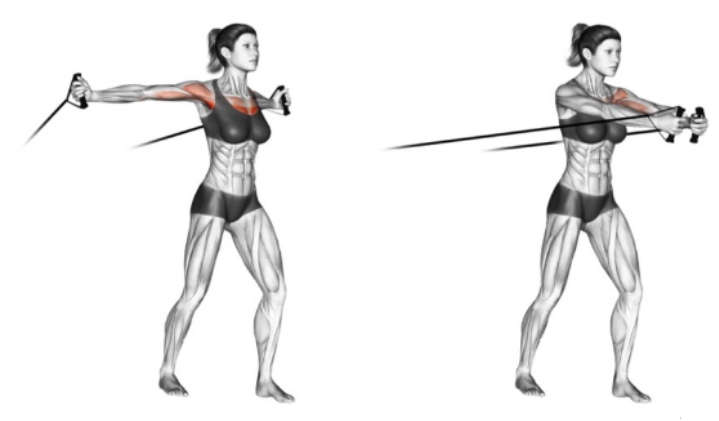Resistance bands are useful equipment that can give your chest exercises a new perspective. These bands keep your muscles stretched during every exercise, which works your muscles more than just lifting weights the traditional way. We’ll look at ideal resistance band chest exercises in this post to help you build and shape your chest muscles. All fitness levels can benefit from these workouts, whether you’re a beginner trying to develop your chest or a professional lifter looking to change things out. Resistance band chest exercises, including these workouts in your daily routine can help you develop a stronger, bigger chest.
Benefits of Using Resistance Bands
Before we dive into the exercises, let’s briefly discuss the benefits of using resistance bands for your workouts. Resistance bands offer several advantages, including:
Versatility
Resistance bands give exceptional versatility for chest exercises, allowing you to target different muscle groups with ease. From chest presses to flyes and even push-ups, these bands provide adjustable resistance levels to accommodate your fitness level and goals. Whether you’re working out at home or on the go, resistance bands give a convenient and effective way to strengthen and sculpt your chest muscles for a defined and toned upper body.
Portability
The portability of resistance bands makes them a good choice for chest exercises, enabling you to work out anytime, anywhere. Compact and lightweight, resistance bands can be easily packed into a gym bag or suitcase, allowing you to stay consistent with your workouts even while traveling. Whether you’re at home, in the office, or outdoors, resistance bands provide a convenient solution for maintaining your chest strength and fitness goals on the go.
Adjustable Resistance
One of the key benefits of using resistance bands for chest exercises is their adjustable resistance levels. With bands available in different strengths, you can easily customize your workout to match your fitness level and goals. Whether you’re a beginner or an experienced athlete, resistance bands provide the flexibility to increase or decrease resistance as needed, allowing you to challenge your chest muscles and progress over time for optimal results.
Joint-Friendly
Resistance band chest exercises give joint-friendly benefits, making them suitable for people with joint issues or injuries. Unlike heavy weights, resistance bands provide constant tension throughout the range of motion, reducing stress on the joints and minimizing the risk of injury. This gentle yet effective resistance allows you to strengthen your chest muscles without putting excessive strain on your joints, promoting safe and effective workouts for long-term joint health.
Choosing the Right Resistance Band
Choosing the right resistance band is crucial for effective chest workouts. Consider the band’s resistance level, which should challenge your muscles without causing strain. Look for durable bands with comfortable handles. When selecting exercises, aim for a variety that targets different areas of the chest. Resistance band chest exercises options include chest presses, flyes, and push-ups. Incorporate these exercises into your routine to build strength and definition in your chest muscles.
Safety Precautions
When doing resistance band chest exercises, it’s important to follow safety precautions to prevent injury and ensure an effective workout. Here are some detailed safety precautions to keep in mind:
- Check the Band: Before starting your workout, inspect the resistance band for any tears, wear, or damage. Replace any bands that show signs of wear to avoid injury.
- Secure the Band: Anchor the resistance band securely to a stable object, such as a sturdy pole or door anchor, to prevent it from slipping or snapping during exercises.
- Proper Form: Maintain proper form throughout each exercise to target the chest muscles effectively and avoid strain on other muscle groups or joints.
- Start Slowly: Start with less resistance if you’re new to resistance band training, and as you gain strength and confidence, gradually raise the level of difficulty.
- Avoid Overstretching: Do not overstretch the resistance band, as it can lead to the band snapping back and causing injury.
- Controlled Movements: Perform each exercise with slow, controlled movements to avoid jerking or snapping the band, which can lead to injury.
- Listen to Your Body: If you feel any discomfort or pain while using the resistance band, stop the exercise immediately and seek guidance from a fitness professional or healthcare provider.
- Stay Hydrated: Drink plenty of water before, during, and after your workout to stay hydrated and help prevent muscle cramps.
By following these safety precautions, you can enjoy a safe and effective resistance band chest exercises.
Warm-Up Exercises
Warming up is crucial before any exercise, especially those using resistance bands. It prepares your muscles for the workout, reducing the risk of injury. Start with arm circles, gently moving your arms in circular motions. Follow with shoulder rolls, lifting and rolling your shoulders back. Next, do chest stretches, clasping your hands behind your back and pulling gently. Complete your warm-up with a few sets of resistance band shoulder presses to activate your chest muscles.
Resistance Band Chest Exercises
Resistance Band Chest Press
- At chest height, secure the resistance band to a strong object.
- Hold the ends of the band in each hand and step away from the anchor point to create tension.
- Stretch your arms straight out in front of you at chest height while keeping your feet shoulder-width apart.
- Slowly push your arms forward until they are fully extended, then return to the starting position.
- Repeat for the desired number of repetitions.

Resistance Band Chest Fly
- At chest height, secure the resistance band to a strong object.
- Hold the ends of the band in each hand and step away from the anchor point to create tension.
- Arrange your feet shoulder-width apart and hold your arms out in front of you, chest height.
- Slowly bring your arms together in front of you, keeping a slight bend in your elbows.
- Return to the starting position and repeat.

Resistance Band Push-Up
- Place the resistance band across your upper back and hold the ends in each hand.
- Move your hands a little more than shoulder-width apart to form a push up position.
- Lower your body towards the floor, keeping your core engaged and your elbows close to your sides.
- Return to the beginning posture by pushing yourself up again.

Tips for Effective Chest Workouts with Resistance Bands
Using resistance band chest exercises can be highly effective. Here are some tips to make the most of your resistance band chest exercises:
- Maintain Proper Form: Focus on keeping your back straight, shoulders down and back, and core engaged throughout each exercise. This helps target the chest muscles more effectively and reduces the risk of injury.
- Control the Movement: Do not do the workouts with speed. Instead, focus on controlled movements, both during the concentric (lifting) and eccentric (lowering) phases, to maximize muscle engagement.
- Full Range of Motion: Try to perform each exercise through its full range of motion to fully engage the chest muscles. This helps in achieving better muscle activation and growth.
- Mind-Muscle Connection: Concentrate on feeling the chest muscles working during each repetition. This can help enhance the effectiveness of the exercise and improve muscle activation.
- Variety is Key: Incorporate a variety of chest exercises into your routine to target the muscles from different angles. This will help keep your training fresh and avoid high workout levels.
- Progressive Overload: Gradually increase the resistance or the number of repetitions/sets as your strength improves. This is key for muscle growth and strength gains.
- Rest and Recovery: Allow adequate rest between workouts to allow your muscles to recover and grow. Overtraining can lead to muscle fatigue and potential injury.
- Listen to Your Body: If you feel any discomfort or pain, stop the exercise immediately. Understanding your boundaries and not going over them is important.
By following these tips, you can effectively use resistance band chest exercises and achieve your fitness goals.
Conclusion
In conclusion, adding resistance band chest exercises to your workout routine can completely transform your chest exercises and provide a new method for developing and shaping your muscles. These bands suit bodybuilders of all skill levels, from beginners to specialists, with exercises including push-ups, flies, and chest presses. Multiple benefits result from this, such as increased muscular activation, flexibility, and resistance that is easy on joints. Safety precautions are essential for ensuring injury-free exercise. Just keep in mind to proceed slowly, keep good form, and select the appropriate band. You may create a stronger, more defined chest over time by following these rules and making the most of your resistance band chest workouts.
FAQs
Q. How often should I do resistance band chest exercises?
It is recommended to do resistance band chest exercises 2-3 times per week, allowing for rest days in between.
Q. Can resistance band chest exercises help reduce chest fat?
While resistance band exercises can help strengthen and tone the chest muscles, they alone may not reduce chest fat. A combination of regular exercise, a balanced diet, and overall fat loss may help reduce chest fat.
Q. Are resistance band chest exercises suitable for beginners?
Yes, resistance band chest exercises can be suitable for beginners. To prevent damage, it’s critical to begin with lower resistance and focus on good form.
Q. Can resistance band chest exercises replace traditional weightlifting exercises?
Resistance band chest exercises can be a valuable addition to your workout routine, but they may not fully replace traditional weightlifting exercises. It’s beneficial to include a variety of exercises for overall muscle development.
Q. How long do resistance band chest workouts take to show results?
Results can vary depending on various factors, such as consistency, diet, and individual fitness level. With regular exercise and a balanced diet, you may start to see results in a few weeks to a few months.

